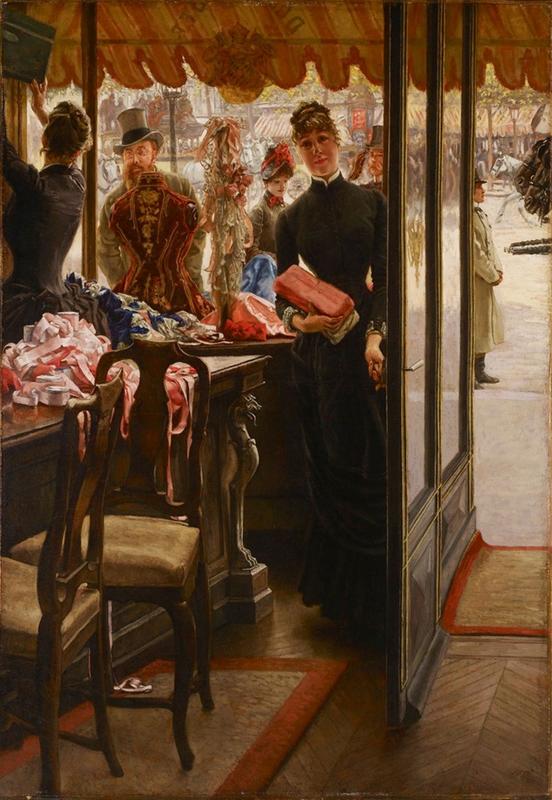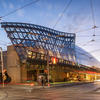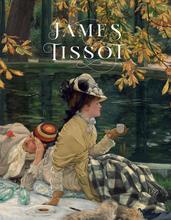More about The Shop Girl
- All
- Info
- Video
- Shop

Contributor
What’s really for sale here? There’s a lot going on in Tissot’s painting
Though he painted during the same period as the impressionists we all know and love, James Tissot was best known for his genre scenes depicting fashionable high society. His more traditional, academic style renders women’s clothing in detail, and is often a focal point of his work. Like impressionists such as Manet and Caillebotte, Tissot focusing his attentions here on the figures of the flâneur and the female service worker.
This scene just about sums up the new social and commercial landscapes of Paris in the late 19th century. This painting is in fact part of a larger series by Tissot titled "Quinze tableau sur la femme à Paris" (Fifteen paintings on the woman of Paris), which depict young ingénues, wives of politicians, circus performers, and artists’ wives, among others. Paris provided the perfect backdrop for the new world depicted by Tissot and others, having changed rapidly within the 19th century. Georges-Eugène Haussmann’s redesign of Paris, which spanned from 1853 to 1870, created a city with broad, tree-lined boulevards, open public gardens, and a unified Beaux Arts-style architecture. This new and improved (though really it was probably all about making sure a Les Mis style barricade could never happen again) city was designed for the flâneur, whose ambition to see and be seen defined the urban culture of the time.
The flâneur appears frequently in Impressionist works, and the term basically means a fashionable man, usually rich and living a life of leisure, who strolls around town all day, dressed up in the latest fashions. He frequents the dance halls and boating parties of Renoir, consuming all the city has to offer, and that includes partaking in the new commercial landscape that grew alongside the increasing industrialization and modernization of this city itself. We can see the flâneur peeking through the window in this work, his top hat placed at a jaunty angle.
Consumer culture was on a steady rise throughout the 19th century, and by the last quarter, the department store has cemented its place in the urban fashion landscape. The stores from which the world-renowned fashions of Paris flowed were largely staffed by women and retail work was a firmly feminine profession.However, unlike the fashionable and celebrated flâneur and flâneuse (a female flâneur), the women who sold clothing and small fashion goods like those seen in this painting, were largely considered to occupy a decidedly low rung on the societal ladder. Not only were these women to be chided for working instead of staying at home with the kids or tending house, but their public-facing roles were cast in a distinctly sexual light. The women who worked in shops, usually fashionably dressed and attractive, were seen as sexually available to their male customers, as the fashion trades were known for being rife with prostitution. Impressionist depictions of women in these public-facing roles, both in commerce and the Parisian nightlife, show these assumptions of sexual availability, most famously seen in Manet’s The Bar at the Folies-Bergère.
So back to Tissot’s work for some fancy-schmancy formal analysis. We can clearly see the gaze of the flâneur meeting that of the shop girl replacing a box on the shelf in the upper left corner of the painting. This is a similar detail to the presumed interaction that can be seen in the mirror in The Bar at the Folies-Bergère, in which we see the fashionable flâneur seeking to consume both the goods for sale and woman selling them. It’s also interesting to note that in this painting, the furniture, the clothing, the ribbons and trimming for sale, and the interior of the shop are all rendered in exquisite detail. Unlike his Impressionist contemporaries, nothing in this painting is is left to suggestion by a few artful brushstrokes. The equal attention paid to the women and the goods shows a type of equivalence between the two. The men at the window are there to ogle the women as much as they are to shop, and in fact, the pretty shop girls who willingly meet their direct gaze are an integral part of the shopping experience, driving the contemporary rise in consumerism.
The viewer, who is likely presumed to be male, is invited to make eye contact with the shop girl in the foreground, who is pictured opening the shop door for a departing customer. You’ll notice that the woman depicted on the street in the back of this has a downcast gaze. Though the contents of this shop are undoubtedly well within her consumer wheelhouse, the main article of consumption in this scene (the shop girls) are not here for her enjoyment. This painting is more than a still life of a typical Parisian shop. It shows a specific, eroticized moment, one of many playing out in a modern Paris ruled by fashion and consumer culture.
Sources
- Clayson, Hollis. Painted Love: Prostitution in French Art of the Impressionist Era. Los Angeles, CA: Getty Research Institute, 2003.
- Dilet, Marc. "Haussmann, Georges Eugène, Baron." Grove Art Online. 2003. Accessed October 03, 2018. http://www.oxfordartonline.com.libproxy.smith.edu:2048/groveart/view/10…
- Misfeldt, Willard E. "Tissot, James." Grove Art Online. 2003. Accessed October 03, 2018. http://www.oxfordartonline.com.libproxy.smith.edu:2048/groveart/view/10….
- Tate. "Flâneur – Art Term." Tate. Accessed October 03, 2018. https://www.tate.org.uk/art/art-terms/f/flaneur.
- Cox, Pamela. "Shop Girls, Social History and Social Theory." Revista Brasileira De História 37, no. 75 (August 2016). August 6, 2016. Accessed October 3, 2018. http://www.scielo.br/scielo.php?script=sci_arttext&pid=S0102-0188201700…
Featured Content
Here is what Wikipedia says about The Shop Girl (Tissot)
The Shop Girl (La Demoiselle de Magasin) is a painting by James Tissot in the collection of the Art Gallery of Ontario. The painting depicts a young woman standing inside a shop selling ribbons and dresses. In one hand she holds a wrapped package of newly purchased items. With the other she holds open the door to the store for the viewer to depart. The shop is filled with piles of ribbons. Outside, a busy Parisian street scene is visible through the shop windows. A well dressed man stares in through the window and is greeted by the other girl in the shop.
The painting was created in the period 1883–1885 using Tissot's distinctive style of dry pigments and small brush strokes—not impressionism, but still a major departure from the Academy style. It also reflects some of Tissot's main interests, such as the materialistic world of objects and clothing of the late nineteenth century. The painting also employs Tissot's favourite technique of this period of placing the observer directly in the painting, with the shop girl holding the door open for us. It was first exhibited in 1885 at the Galerie Sedelmeyer. It was a part of an exhibit Tissot titled Quinze tableau sur la femme à Paris (fifteen paintings on the woman of Paris). It was his last major exhibition before Tissot embraced religious subjects and spent the rest of his life painting scenes from the Bible. The painting was gifted to the Art Gallery of Ontario in 1968.
Regina Haggo sees this painting as a depiction of barely contained lust. On the floor a fallen ribbon makes a clear heart shape. To Haggo the position of the heart on the floor makes clear this is a baser form of desire. The women are modestly clothed, but Tissot emphasizes their figures, especially the breasts of the woman raising her arms. In this period a woman working outside the home was considered morally dubious. The leering man and the vantage of the viewer can suggest that more than just the clothing is for sale. The man outside may be flirting with the shop girl, but Haggo notes that Tissot emasculated him by having a women's torso overlap his own.
Check out the full Wikipedia article about The Shop Girl (Tissot)















The painting depicts a young woman standing inside a shop selling ribbons and dresses. In one hand she holds a wrapped package which indicates she has just purchased some items. With the other she holds open the door to the store for the viewer to depart. The shop is filled with piles of ribbons. Outside a busy street scene is visible through the shop windows. A well dressed man stares in through the window and is greeted by the other girl in the shop. The shop is adorned with beautiful colors, it draw your eyes to the little details instead of one particular person, because you are seeing it from the viewer perspective. Unlike other paintings where you watch it from and outside point of view it really feels like you are in the shop in this painting and interacting with the people around.